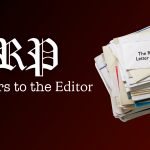
The Reading Post accepts Letters to the Editor. All letters must be signed. The Reading Post reserves the right to edit or not publish any letters received. Letters do not represent the views or opinions of the Post.
To The Editor:
 My name is Dan Ensminger. I am a 39-year resident of Reading and a current member and former Chair of the Board of Selectmen. My three children attended Reading schools and reaped many benefits from their years there. My wife Joan and I look forward to spending many more years in this fine town.
My name is Dan Ensminger. I am a 39-year resident of Reading and a current member and former Chair of the Board of Selectmen. My three children attended Reading schools and reaped many benefits from their years there. My wife Joan and I look forward to spending many more years in this fine town.
I am writing a series of letters to the editor to give Reading voters some background on our Town finances, explain the financial challenges we have faced, and outline the reasons why we are bringing a Proposition 2 ½ Override question to the ballot in a special election on October 18. The tone of my letters will be informational and in a Q&A format designed to answer the many questions that I have been asked concerning the Override. I welcome comments and additional questions from your readers.
What is Proposition 2 ½?
An initiative petition was passed in 1980 and implemented in 1982 that limits the annual property tax (the tax levy) increase in MA communities to +2.5% plus any New Growth. The term “annual” applies to a city or town’s fiscal year (FY), which begins on July 1 and ends on June 30 of the subsequent year. In Reading, we are currently in FY-17 which began on 7/1/2016 and ends on 6/30/2017.
An Override seeks to permanently increase the tax levy limit by a specified dollar amount. If the Override is approved by the voters, annual tax increases are again limited to +2.5%, but using the increased levy limit as the basis. Note that capital or debt exclusions, such as Reading has currently in place for both the High School and Library projects, may be added on top of this +2.5% limit when approved by the voters. These exclusions are temporary – for a specified amount of time. When the projects are paid for, this part of the tax bill vanishes.
Proposition 2 ½ contains two limitations on the amount of property tax a city or town can raise:
- The Levy Ceiling, the absolute upper limit on the locality’s tax levy, is equal to 2.5% of the total full and fair cash value of all taxable real and personal property in the community. The community’s levy cannot be raised beyond this limit under any circumstances. For Reading:
FY-16 Total Taxable Property Value $4,309,708,047
2 ½% limit 0.025
FY-16 Tax Levy Ceiling $107,742,701
- The property tax Levy Limit is the maximum amount a community can levy in a given year. It is equal to last year’s levy limit plus 2.5%, plus new growth, plus prior debt exclusion / override amounts if applicable. For Reading:
FY-15 Levy Limit was $ 57,353,223
Times 2 ½% $ 1,433,831
FY-16 New Growth $ 912,485
FY-16 Total Levy Limit (before debt) $ 59,699,539
FY-16 Total Levy Limit (with debt) $ 62,514,360
FY-16 Actual Tax Levy (with debt) $ 62,490,767
Note that in FY-16, Reading’s actual levied taxes came within $23,593 of its total authorized levy limit.
New Growth is the increase in the tax base due to new construction, parcel subdivisions, condo conversions and property renovations, but not due to revaluation. It is calculated by multiplying the property’s increased assessed value by the prior year’s tax rate for the property class. Reading’s New Growth numbers over the last ten fiscal years have ranged from $324,532 in FY-12 to FY-16’s high of $912,485. A major component of FY-16’s relatively high New Growth number was the addition to the tax base of dozens of condos in the 300+ unit Reading Woods development at the former Addison Wesley site. Past contributors to New Growth have include Reading Woods, the Archstone apartment development off lower West Street, Johnson Woods, the Oaktree development (former Atlantic Markets site), and the Walkers Brook Drive complex that includes Jordans, Home Depot, and multiple restaurants and commercial properties.
An important point to note is that even at their maximum, Reading’s recent New Growth numbers have not added more than 1.6% to the tax base in a given fiscal year. As I will point out in a later letter, our peer communities have experienced several times Reading’s average annual New Growth. I will also discuss in that letter what Reading is doing to close this gap.
How Does Proposition 2 ½ Affect My Property Taxes?
The levy limit provisions of proposition 2 ½ affect the total amount of taxes that may be raised by a city or town. This in in turn determines the average tax rate over all classes of property. If all properties in Reading were to go up in assessed value by the same percent in a given year, that factor alone would not raise an individual’s property tax. In general, if an override were to be passed, the tax rate would go up on all properties. However, year-to-year changes in a particular property’s assessed value may be up or down. When that property’s assessed value is multiplied by the tax rate, its property tax bill may go up or down.
What is Classification? How does it work with Proposition 2 ½?
The voters adopted the Classification Amendment to the Massachusetts Constitution in 1978. It allowed cities and towns to categorize real estate and personal property into five classes-Residential, Open Space, Commercial, Industrial and Personal Property – and to tax these classes at different tax rates.
Proposition 2 ½ affects the total amount of property tax that can be raised across all classes of property in a city or town. Classification affects which classes of taxpayers will pay what specific share of the total tax levy. Thus, classification cannot be used as a means to raise additional tax monies for a city or town. The Board of Selectmen are required under State law to determine annually the share of taxes to be paid by residential/open space properties vs. commercial/industrial/personal properties.
I will have more detail on Reading’s history of tax classification in a subsequent letter.
NEXT TIME: Why is a Special Election being called on October 18 for the override? Why does the Town always ask for a Proposition 2 ½ override every ten years or so?
Daniel Ensminger, 6 Oakland Road, Reading, Member & Former Chair, Reading Board of Selectmen



